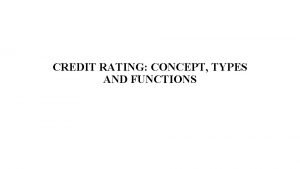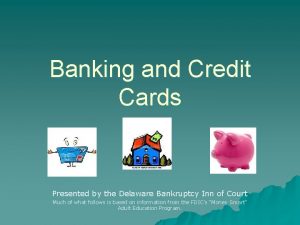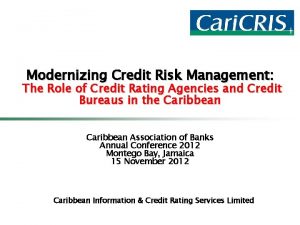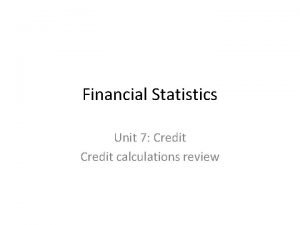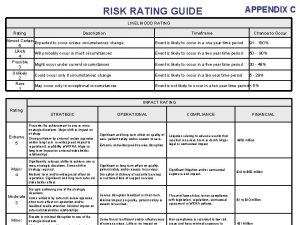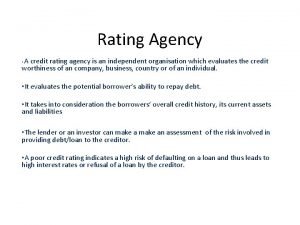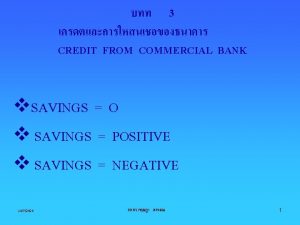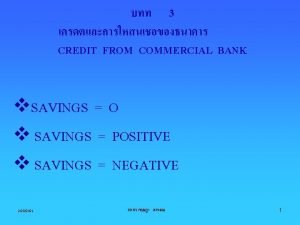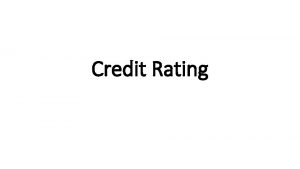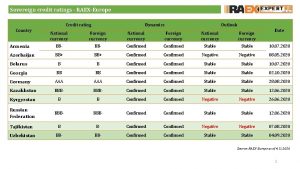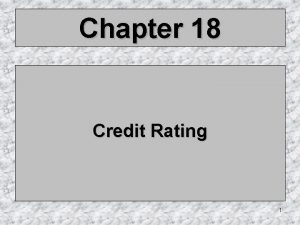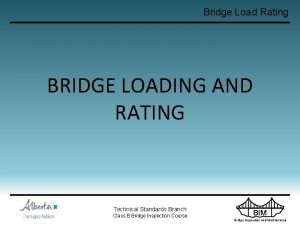CREDIT RATING CONCEPT TYPES AND FUNCTIONS INTRODUCTION Many




















- Slides: 20

CREDIT RATING: CONCEPT, TYPES AND FUNCTIONS

INTRODUCTION • Many a times it has happened that investors in debentures or fixed deposits were shown rosy pictures of companies and offered very high rates of interests by bogus companies and in the end the investor neither got his money back nor the promised interest. • Actually, it is very difficult for an individual investor to gather details about creditworthiness of a company, neither he has the time nor the skills to undertake risk evaluation. • Credit rating agencies investigate the financial position of the company issuing various kinds of instruments and assess risks involved in investing money in them. • the credit rating agency rate the risks involved in investment in instruments of a particular company, they may rank it from very safe to very risky.

DEFINITION • Credit rating system can be defined as an act of assigning values to credit instruments by assessing the solvency i. e. , the ability of the borrower to repay debt, and expressing them through pre-determined symbols. • Investopedia defines Credit Rating as “An assessment of the creditworthiness of a borrower in general terms or with respect to a particular debt or financial obligation”.

CHARACTERISTICS OF CREDIT RATING 1. 2. 3. 4. 5. Assessment of issuer's capacity to repay. Based on data. Expressed in symbols. Done by expert. Guidance about investment-not recommendation.

WHAT CREDIT RATING IS NOT 1. 2. 3. 4. Not for company as a whole. Does not create a fiduciary relationship (Relationship of trust) Not attestation of truthfulness of information provided by rated company. Rating not forever.

COMPULSORY CREDIT RATING 1. 2. 3. 4. For debt securities. Public deposits. For commercial papers (CPs). For fixed deposits with non-banking financial institutions (NBFCs).

CREDIT RATING AGENCIES IN INDIA 1. 2. 3. 4. Credit Rating and Information Services of India Limited (CRISIL) Investment Information and Credit rating agency (ICRA) Credit Analysis & Research Ltd. (CARE) ONICRA

Credit Rating and Information Services of India Limited (CRISIL) • It is India’s first credit rating agency which was incorporated and promoted by the erstwhile ICICI Ltd, along with UTI and other financial institutions in 1987. • After 1 year, i. e. in 1988 it commenced its operations • It has its head office in Mumbai. • It is India’s foremost provider of ratings, data and research, analytics and solutions, with a strong track record of growth and innovation. • It delivers independent opinions and efficient solutions. • CRISIL’s businesses operate from 8 countries including USA, Argentina, Poland, UK, India, China, Hong Kong and Singapore. • CRISIL’s majority shareholder is Standard & Poor’s. • It also works with governments and policy-makers in India and other emerging markets in the infrastructure domain.

Investment Information and Credit rating agency (ICRA) • The second credit rating agency incorporated in India was ICRA in 1991. • It was set up by leading financial/investment institutions, commercial banks and financial services companies as an independent and professional investment Information and Credit Rating Agency. • It is a public limited company. • It has its head office in New Delhi. • ICRA’s majority shareholder is Moody’s.

Credit Analysis & Research Ltd. (CARE) • • CARE was established in 1993. It is the second-largest credit rating agency in India. It has its head office in Mumbai. CARE Ratings is one of the 5 partners of an international rating agency called ARC Ratings.

ONICRA • It is a private sector agency set up by Onida Finance. • It has its head office in Gurgaon. • It provides ratings, risk assessment and analytical solutions to Individuals, MSMEs and Corporates. • It is one of only 7 agencies licensed by NSIC (National Small Industries Corporation) to rate SMEs. • They have offices over 125 locations in India. •

FACTORS CONSIDERED IN CREDIT RATING 1. 2. 3. 4. 5. 6. 7. Issuers ability to service its debt. Market positon of the company. Quality of management. Legal position of the instrument. Industry risks. Regulatory environment. Other factors.

PROCESS OF CREDIT RATING 1. An agreement is entered into between the rating agency and the issuer company. 2. Appointment of analytical team. The rating agency assigns the job to a team of experts. 3. Appointment of analytical team. The rating agency assigns the job to a team of experts. 4. Meeting the officials. To obtain clarifications and understanding the client's business the analytical team visits and interacts with the executives of the client. 5. Discussion about findings with internal committee. 6. Meeting of the rating committee. generally comprises of a few directors and is the final authority for assigning ratings. 7. Communication of decision. 8. Information to the public through reports and the press. 9. Revision of the rating.

TYPES OF CREDIT RATING 1. 2. 3. 4. 5. 6. 7. 8. 9. 10. 11. Rating of bonds and debentures. Rating of equity shares. Rating of preference shares. Rating of medium term loans (Public deposits, CDs etc. ). Rating of short-term instruments [Commercial Papers (CPs)I Rating of borrowers. Rating of real estate builders and developers. Ratings of insurance companies. Rating of collective investment schemes. Rating of banks. Rating of countries and states.

FUNCTIONS/IMPORTANCE OF CREDIT RATING 1. 2. 3. 4. 5. 6. 7. It provides unbiased opinion to investors. Provide quality and dependable information. Provide information in easy to understand language. Provide information free of cost or at nominal cost. Helps investors in taking investment decisions. Disciplines corporate borrowers.

BENEFITS OF CREDIT RATING 1. 2. 3. 4. Benefits to investors Benefits to the rated company Benefits to intermediaries Benefits to the business world

BENEFITS TO INVESTORS 1. 2. 3. 4. 5. Assessment of risk. Information at low cost. Advantage of continuous monitoring. Provides the investors a choice of Investment. Ratings by credit rating agencies is dependable.

BENEFITS TO THE RATED COMPANY 1. 2. 3. 4. 5. 6. 7. Ease in borrowings. Borrowing at cheaper rates. Facilitates growth. Recognition of lesser known companies. Adds to the goodwill of the rated company. Imposes financial discipline on borrowers. Greater information disclosure.

BENEFITS TO INTERMEDIARIES • Merchant bankers and Brokers job made easy BENEFITS TO THE BUSINESS WORLD • Increase in investor population • Guidance to foreign investors.

THANK YOU COMMERCESTUDYGUIDE.
 Credit rating functions
Credit rating functions Riset rating dan non rating
Riset rating dan non rating How many types of credit are there?
How many types of credit are there? Credit rating scale
Credit rating scale Credit rating spread table
Credit rating spread table Msc credit rating
Msc credit rating Credit rating definition
Credit rating definition Mrs cykmans credit card was stolen
Mrs cykmans credit card was stolen Https://myfinance.crisil.com,
Https://myfinance.crisil.com, Oracle credit management application
Oracle credit management application This can be avoided by giving credit where credit is due.
This can be avoided by giving credit where credit is due. Many sellers and many buyers
Many sellers and many buyers Many sellers and many buyers
Many sellers and many buyers Monique buys a $4 700
Monique buys a $4 700 3-1 introduction to consumer credit
3-1 introduction to consumer credit Managing credit unit test
Managing credit unit test Types of credit risks
Types of credit risks How to solve evaluating functions
How to solve evaluating functions Evaluating functions and operations on functions
Evaluating functions and operations on functions Carl rogers real self and ideal self
Carl rogers real self and ideal self Contoh selling concept
Contoh selling concept
